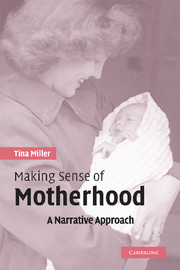Book contents
- Frontmatter
- Contents
- Dedication
- Acknowledgements
- Introduction
- 1 The storied human life: a narrative approach
- 2 Making sense of motherhood: cultural scripts
- 3 Setting the Western context: mothering in late-modern society
- 4 Anticipating motherhood: the antenatal period
- 5 Making sense of early mothering experiences
- 6 A return to normal: becoming the expert
- 7 Conclusions and reflections: making sense of motherhood
- References
- Index
5 - Making sense of early mothering experiences
Published online by Cambridge University Press: 22 September 2009
- Frontmatter
- Contents
- Dedication
- Acknowledgements
- Introduction
- 1 The storied human life: a narrative approach
- 2 Making sense of motherhood: cultural scripts
- 3 Setting the Western context: mothering in late-modern society
- 4 Anticipating motherhood: the antenatal period
- 5 Making sense of early mothering experiences
- 6 A return to normal: becoming the expert
- 7 Conclusions and reflections: making sense of motherhood
- References
- Index
Summary
I think I kind of expected to be more in control of the situation and I wasn't really at all. In fact I just didn't know what to do, it was all completely new to me and I felt very kind of overwhelmed by the whole experience.
(Philippa, interviewed seven weeks after the birth of her first child)The subjective experience of being a mother, in contrast to anticipating motherhood, can throw lives into temporary confusion. As noted earlier, transformations in patterns of living and changes in the timing and frequency of childbearing have implications for constructions of motherhood in late modernity. In the Western world, changes in family size and ways of living mean that many women come to motherhood with little or no first-hand experience of its dimensions. At the same time, geographical mobility and more women working outside the home translates into traditional patterns of family support not necessarily being readily available. In this chapter, the ways in which new mothers make sense of their early mothering experiences are explored through the narratives they construct. These continue to draw on recognisable cultural notions of right ways of doing and being. Presenting a self as a responsible mother involves self-governance around what can and cannot be voiced. As noted in the previous chapter, the narratives produced in the antenatal period were tentative, drawing on essentialist ideas of women's natural capacity to give birth and instinctively cope, whilst at the same time acting responsibly, through interactions with experts and expert practices.
- Type
- Chapter
- Information
- Making Sense of MotherhoodA Narrative Approach, pp. 89 - 111Publisher: Cambridge University PressPrint publication year: 2005



